Arthrosis of the knee joint (also called gonarthrosis) is a lesion of the knee joint, as a result of which the articular cartilage is destroyed, the knee is deformed and the movement of the knee is limited. The article will help you learn about the symptoms and start the necessary treatment in a timely manner.
Arthrosis of the knee joint
Specialists subdivide gonarthrosis into primary and secondary forms:
- The cause of the primary form is a congenital defect of the joint and the period of development of the disease occurs in childhood and adolescence.
- The secondary form can develop at any age.

Experts call the main causes of the disease:
- poor posture;
- being overweight;
- various kinds of knee injuries;
- disorders of mineral metabolism and metabolism;
- the presence of endocrine diseases;
- increased stress on the knee joints;
- impaired calcium metabolism due to the intake of hormone-containing drugs;
- meniscus removal operations;
- presence of arthritis;
- weak ligamentous apparatus;
- menopause and menopause in women.
Arthrosis of the knee joints can be bilateral or unilateral.
Stages of arthrosis and their symptoms
Depending on the symptoms and approach to the disease, specialists divide the disease into 3 stages.
Initial or 1st stage of arthrosis
At this stage, mild pain appears with increased stress on the knee.The initial stage can last from 1 year to several years.In order to prevent the stage from becoming more severe, a number of measures should be taken to restore the deformed cartilage, strengthen the ligaments and restore movement in the knee.
At this stage, timely treatment will completely get rid of the pathology. But most patients ignore the symptom in the form of mild pain and therefore do not go to the doctor. Knee arthrosis is treated by an orthopedist, rheumatologist or surgeon.
Middle or 2nd stage of arthrosis
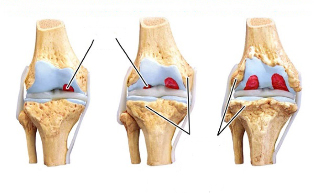
At this stage, the symptoms of the disease appear more pronounced and therefore it is impossible to ignore them. Doctors note that it is at stage 2 that most patients seek medical help. At this stage, an accurate diagnosis can be made. Timely treatment allows you to stop the transition of the disease to the 3rd degree.
Severe symptoms include:
- aching knees with hypothermia;
- the presence of a soft crunch;
- swelling or swelling in the knee area;
- severe knee pain when climbing stairs or other forms of increased stress;
- pain and tingling in the calves;
- Stiffness in flexion and extension of the knee.
Last or 3rd stage of arthrosis
At this stage, the consequences of the disease are irreversible, it is impossible to stop the development of pathology. But the treatment will ease the patient's condition for a while. In no case should you ignore the symptoms or self-medicate, as this can lead to a change in gait, walking with a stick, or disability.
The main symptoms of stage 3, in addition to the above, are referred to by doctors:
- pathology of the endocrine system (problems with the thyroid gland, diabetes);
- hereditary and age factors.
Diagnostic methods
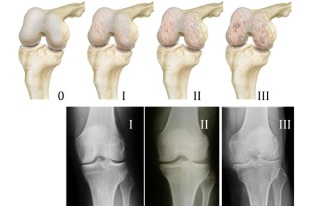
The specialist makes a diagnosis based on the anamnesis from the patient's words and the results of laboratory and instrumental studies.
Laboratory tests include:
- complete blood count.With the help of research, you can identify the causative agent of the disease and assess the degree of inflammation.
- general urinalysisallows you to identify or exclude the autoimmune origin of the disease and assess whether the source of kidney and urinary tract pathology.
- biochemical blood test, which is divided into many others, the indicators of almost all studies are outside the normal range.
Laboratory tests are carried out during an exacerbation of the disease, since during remission all indicators are within normal limits.
Instrumental studies include:
- X-ray.It is performed in two projections - posterior-anterior and lateral. Usually, the doctor takes a picture of both knees to compare the affected and healthy knees.
- arthroscopy.This procedure should be understood not only as research, but also as a mini-operation. The fact is that through a small hole in the knee, the doctor inserts a small LED conductor inside and a complete picture of the internal state of the knee is displayed on the computer screen, the resulting tissue fragments are sent to the laboratory if there is a suspicion of a cartilaginous or malignant tumor. endoscopically it is possible to correct the shape of the menisci, remove polyps and chondrophytes. In addition to diagnosing arthrosis, other diseases can be carried out and examined, since the knee joint is a large organ and allows you to get a complete picture of the state of the body.
- Ultrasound(ultrasound).This examination method has 2 important advantages over X-rays - it is harmless and helps to see the soft tissue of the joint due to its wide imaging capabilities.
- CT (computed tomography).The study is a form of radiography of an improved form, since during this procedure the doctor takes several pictures and thanks to them a three-dimensional image of the affected organ is created on the computer. This form is used less often than others due to time costs and a large amount of radiation.
- MRI (magnetic resonance imaging).Unlike the previous method, it is more harmless. Also, MRI allows you to get a better picture of soft tissues compared to CT. But MRI is used as rarely as CT, since its use requires high material costs and cannot be applied to patients in whose body there are any metal objects (pins, crowns). CT and MRI are contraindicated in people weighing more than 120 kg.
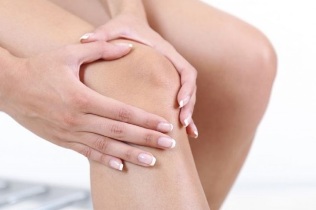 scintigraphy.An expensive and radiation-related method. Therefore, it is used in cases where less expensive methods are ineffective. In this study, a substance is injected into the patient's body, which reacts to the diseased organ and is localized around it.
scintigraphy.An expensive and radiation-related method. Therefore, it is used in cases where less expensive methods are ineffective. In this study, a substance is injected into the patient's body, which reacts to the diseased organ and is localized around it. - tomography.The study is based on thermal radiation from the body surface. Usually, the affected organ manifests itself in the form of foci with an increased temperature. The tomograph is a cumbersome instrument, and the procedure is expensive, so this study is carried out only in large clinics.
Medicines to treat and relieve symptoms
Experts note that it is impossible to start treatment without relieving pain and eliminating inflammation.Therefore, doctors prescribe various non-steroidal (that is, non-hormonal) drugs. But they cannot be taken longer than the prescribed period, since this group of medicines does not cure the disease, but alleviates the symptoms, and the disease progresses in the meantime.
Ointments for arthrosis
Treatment of arthrosis of the knee joint with symptoms of edema and pain is rarely done without ointments.
Unlike other forms of drug release, this group has clear advantages:
- quickly reduces pain and inflammation;
- ease of use makes it easy to combine with other treatments such as physiotherapy;
- there is no negative effect on the liver.
Many years of experience in the treatment of arthrosis and research of positive feedback among patients have revealed a number of effective ointments that have a warming vasodilator effect. They contain red pepper extract, bee and snake venom.
Gymnastics for arthrosis
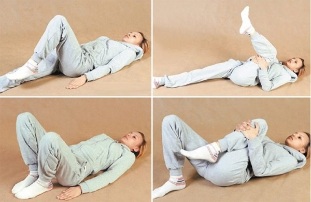
Gymnastics is one of the important methods of treating arthrosis of the knee joint, which should be used during the period of remission after the pain symptoms have been eliminated.
It contributes to:
- improve articular cartilage nutrition and overall health:
- pain relief;
- strengthening the muscles and ligaments of the knee joint;
- increased joint mobility.
In order to see a positive effect,should be exercised daily or every other day, increasing the load up to 30 minutes per workout.
- Warm up. You need to walk on tiptoes or heels for 3-5 minutes.
- Pedal an imaginary bicycle 20-30 times (10-15 times with each foot).
- Lying on your stomach, bend and straighten your knees 10-15 times. With each bend, keep the leg in this position for 5 seconds.
- Extend your legs while lying on your back. Raise your leg and bend at the knee. The heel should be parallel to the floor.
- Lying on your right side, raise your left leg, pull it to your stomach, and then stretch it back as far as possible. Roll over to the other side and repeat the exercise. Repeat 5-6 times for each leg.
Exercise should be abandoned if:
- hernia of the abdomen or hips;
- cardiovascular diseases;
- infectious diseases;
- blood diseases;
- rehabilitation period after operations.
Rubs and compresses

Various rubbing and compresses are widely used in the treatment of arthrosis. Their significant advantages include the availability of ingredients and the absence of side effects.
- Garlic.Pour 1 head of vegetable with any vegetable oil (200 ml), cover and leave in a cool and dark place for 7 days. Then wash the product overnight. To eliminate the specific odor, close the knee with a thick gauze bandage, and in the morning rinse thoroughly with water.
- Egg.Mix vinegar with 1 yolk 1: 1 and immediately rub some of the product into the knee. Apply 3 per week. After rubbing, wrap the knee with something warm.
- Honey.Mix 100 grams of honey and 3 grams of mummy and immediately rub into the knee. Wrap the knee.
- Cabbage.Soak a piece of woolen material with juice from a vegetable and attach to the knee.
- Oatmeal.Boil a regular porridge from 1-2 tablespoons of flakes in water. Do not boil flakes for more than 7 minutes! Place the viscous product on a clean cloth and apply to the knee.
Wraps
Osteoarthritis of the knee joint (symptoms and treatment with medications are indicated above) can, according to experts, be cured by various types of wraps. The most effective are honey and herbal.
According to research, honey wraps help:
- to restore tissues and intra-articular cartilage destroyed by the disease;
- eliminate pain and inflammation;
- burn excess cholesterol.
It's worth noting that honey is most effective when combined with cinnamon.
As for herbal wraps, the above properties have:
- bark of willow, oak, birch, aspen;
- roots of valerian, comfrey, burdock;
- hop, birch, nettle leaves;
- wild rosemary and St. John's wort herbs;
- chamomile flowers, calendula.
Treatment of knee arthrosis with hirudotherapy
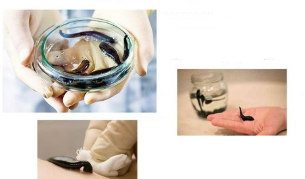
One of the most effective methods of treating arthrosis of the knee joint is hirudotherapy, that is, treatment with leeches. It can be used at the first symptoms and must be directed by the attending physician and under the supervision of specialists. Before the first procedure, you should familiarize yourself with the contraindications.
Do not use leeches:
- children and the elderly;
- patients who suffer from reduced blood clotting, hypotension, severe exhaustion of the body, leukemia, anemia, gastrointestinal erosion, stomach ulcers, problems with the digestive system, cancer, tuberculosis, anemia and hemophilia;
- women during pregnancy and lactation.
In order for the treatment to be effective, 1-2 procedures should be carried out every 5-6 months.Treatment can be carried out more or less often - it all depends on the stage of the disease. If, after 1-3 sessions, the patient feels improvements and does not have allergic reactions, then the treatment with leeches can be continued.
Otherwise, the patient is given a break for 9 months and if the allergy reappears or does not improve, then the hirudotherapy sessions are stopped. During treatment, the specialist treats the knee with an odorless agent, and then checks the leeches that will be used for suitability.
For this, leeches are placed in a vessel with water. If leeches stick to the walls, then they can be used. The specialist puts 2-6 leeches on the patella.
When sucked, leeches release a number of useful enzymes into the human body that will help:
- restore and strengthen the immune system;
- restoration of blood circulation and metabolic processes;
- eliminate swelling and adhesions.
Hirudotherapy cannot be used as a separate treatment. For greater efficiency, experts recommend combining it with physiotherapy, physiotherapy exercises and taking medications.
Taking turpentine and pine baths
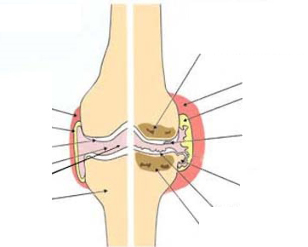
Balneotherapy, that is, taking various baths with a therapeutic effect, is not the last place in eliminating the symptoms of arthrosis.Experts note that there are many different types of therapeutic baths, but turpentine and pine baths have shown particular effectiveness. They can be taken not only at balneological resorts, but also at home.
But despite their benefits, they should be discarded:
- patients with heart disease;
- in the presence of oncological diseases, tuberculosis, varicose veins, diabetes mellitus, epilepsy, atherosclerosis, arterial hypertension,
- if the patient has suffered a heart attack or stroke;
- in the presence of skin diseases;
- for pregnant women.
For a turpentine bath, you need to mix 10 grams of baby soap, 0. 75 ml of salicylic acid and pour the mixture with 500 ml of boiling water. While the mixture is cooling, you need to fill the tub with hot water. When the mixture has cooled to 45 degrees, add turpentine and pour 15-20 ml of the mixture into the bath.
Due to the presence of turpentine, the temperature in the bathroom may seem elevated.Therefore, you must not increase the dose by 1 time more than 20 ml. Baths should be taken daily for 10-14 days, gradually increasing the dose of turpentine mixture to 80 ml in one procedure. After taking a bath, wash off the mixture with warm water and put on warm clothes or lie under a blanket.
For pine baths, you need pine needles or branches. About 25-30 branches need to be broken into small pieces to fit in the pot. Rinse the branches before preparing the broth, float and dirt, pour water and cook for 5-10 minutes. Strain the finished broth and pour it into a hot water bath.
Take a bath for 10-15 minutes.Then wipe dry and put on warm clothes. It is not recommended to engage in physical labor and load the knees. The pine bath treatment course can include 7-12 procedures, which can be taken every other day or daily. After six months, the course can be repeated. This procedure will prolong the period of remission and stop the development of the disease.
Use of chondroprotectors
Arthrosis of the knee joint (symptoms and treatment with folk remedies are listed below) cannot be cured without chondroprotectors - a group of drugs that is aimed at restoring cartilage tissue and its nutrition. All drugs in this group are divided into 5 groups. Medicines that are intended for the treatment of arthrosis belong to group 4.
They are made on the basis of:
- glucosamine;
- chondroitin sulfate;
- avocado and soy extracts;
- hyaluronate and hyaluronic acid;
- synthesis of glucosamine and chondroitin sulfate.
Chondroprotectors are prescribed by specialists in conjunction with anesthetic drugs.But, unlike the latter, the former must be taken throughout life, since only in this case it is possible to slow down the development of arthrosis and stop disability. The effect of taking chondroprotectors is visible only after 2-8 days.
The preparations are available in the form of gels, ointments, tablets and injections. An injection with a solution is given to the knee.
Diet: what foods are allowed, food rules and an approximate diet
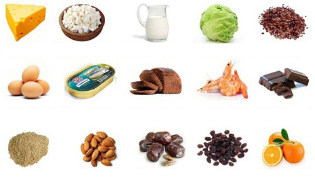
Excess weight negatively affects the development of arthrosis - the disease progresses faster than in patients with normal weight. Therefore, people who are overweight are advised to lose those extra pounds. But at the same time, it is categorically impossible to starve and sit on mono-diets or diets with dietary restrictions.
Allowed products include:
- hormone-free farm meat that can be boiled, baked, stewed or steamed. If there is no access to farm meat, then you can buy ordinary meat, but you should get rid of the skins and fat, since all the harmful substances accumulate there that are fed or injected into animals or poultry. It is better to limit the consumption of such meat to 1-2 times a week, and the rest of the time there are vegetable or fish dishes.
- fruits and vegetables that can be baked or stewed to your liking.
- all types of cereals (excluding instant cereals).
- products with pectin: currants, jelly on fructose;
- fermented milk products;
- eggs;
- wholemeal bread and pasta.
Important to exclude from the diet:
- baked goods, sweets and white bread;
- alcoholic beverages and beer;
- various types of fast food and snacks;
- sausage and other types of finished meat products.
With arthrosis, 1200 Kcal should be consumed daily.You need to eat fractionally, that is, every 2-3 hours in small portions.
Folk remedies
Osteoarthritis of the knee, symptoms and treatment can be easily done with traditional medicine:
- If arthrosis is accompanied by edema, then a blue clay compress will come to the rescue. For it, you need to dilute the clay with water to the state of cream and put it on a dense fabric folded 4-6 times and attach it to the joint. Wrap the knee with gauze or other cloth to prevent the compress from slipping. Keep for 2-3 hours and rinse with warm water. The fabric can be washed and reused.
- Experts recommend giving up natural tea and coffee and replacing them with decoctions and infusions. For example, a lingonberry decoction. For him, 2 tsp. berries need to pour 1 liter. boiling water and leave for an hour, wrapped in a towel. You need to drink 3-4 times a day.
- Massage ointment will help get rid of pain and inflammation at any stage of the disease. For it, you need to mix with 50 grams of petroleum jelly, 10 grams of chopped hops, sweet clover and St. John's wort. You need to insist the product for 2-3 hours in a dark place. Rub in with light massage movements. You can wrap your knee.
How long is the rehabilitation period
It is impossible to say unequivocally how long the rehabilitation of arthrosis will last, since the timing depends on various factors. For example, the age and lifestyle of the patient, the degree and severity of the disease.
In general, the recovery period lasts 1-2 months, during which the patient with the help of specialists:
- removes inflammatory and pain syndromes;
- learns to exercise and adjusts nutrition.
In order for the remission period to last as long as possible, the patient must exercise regularly and see a doctor. Arthrosis of the knee joint with the elimination of symptoms and the proper approach to treatment will allow you not to get out of the usual rhythm of life.



































